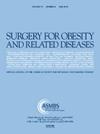Bariatric surgery significantly reduces progression from prediabetes to diabetes compared with the general population: 15-year single-institution data
IF 3.5
3区 医学
Q1 SURGERY
引用次数: 0
Abstract
Background
There is a paucity of literature on the impact for bariatric surgery on the progression from prediabetes (PDM) to type II diabetes mellitus (T2DM).
Objectives
To evaluate the progression from PDM to T2DM in bariatric surgery compared with a nonsurgical cohort.
Setting
Single academic institution, Center of Bariatric Excellence.
Methods
This retrospective study of patients with morbid obesity with patients with PDM who underwent Roux-en-Y gastric bypass (RYGB) or sleeve gastrectomy (SG) between 2001 and 2022. Nonsurgical controls from a primary care cohort were directly matched by hemoglobin A1c, age, sex, and body mass index. DM was defined as a clinical diagnosis of type II diabetes or hemoglobin A1c ≥6.5%. Kaplan-Meier analysis was used to estimate time until T2DM. Cox regression was used to compare time until T2DM in RYGB versus sleeve gastrectomy and in bariatric surgery versus nonsurgical controls.
Results
A total of 1326 bariatric cases with PDM (n = 1154 RYGB, n = 172 SG) were identified. The cohort was 83% female, mean age = 45.3 years, mean body mass index 46.9 kg/m2, and follow-up was 65% over 15 years. In bariatric cases, PDM progression to T2DM at 5, 10, and 15 years after surgery was 1.8%, 3.3%, and 6.7%, respectively. PDM progression to T2DM was almost 20 times greater in matched nonsurgical controls at 5, 10, and 15 years 31.1%, 51.4%, and 68.7%, respectively (hazard ratio 19.8, 95% confidence interval 13.9–28.4, P < .0001). When stratifying by bariatric surgery type, those with SG were 4 times more likely to progress to T2DM versus RYGB (hazard ratio 4.01, 95% confidence interval 1.71–9.39, P = .0014).
Conclusions
Bariatric surgery significantly decreases the conversion from PDM to T2DM. The impact was significantly greater for RYGB compared with SG.
与普通人群相比,减肥手术显著减少了从糖尿病前期到糖尿病的进展:15年单一机构数据。
背景:关于减肥手术对糖尿病前期(PDM)发展为2型糖尿病(T2DM)的影响的文献很少。目的:评估在减肥手术中从PDM到T2DM的进展情况,并与非手术队列进行比较。环境:单一的学术机构,卓越减肥中心。方法:回顾性研究2001年至2022年间接受Roux-en-Y胃旁路术(RYGB)或袖式胃切除术(SG)的病态肥胖合并PDM患者。来自初级保健队列的非手术对照组与血红蛋白A1c、年龄、性别和体重指数直接匹配。糖尿病定义为临床诊断为II型糖尿病或糖化血红蛋白≥6.5%。Kaplan-Meier分析用于估计到2型糖尿病的时间。采用Cox回归比较RYGB组与套筒胃切除术组、减肥手术组与非手术对照组的T2DM发病时间。结果:共发现1326例肥胖合并PDM (n = 1154 RYGB, n = 172 SG)。队列中83%为女性,平均年龄45.3岁,平均体重指数46.9 kg/m2, 15年以上随访率65%。在肥胖病例中,术后5年、10年和15年PDM进展为T2DM的比例分别为1.8%、3.3%和6.7%。在匹配的非手术对照中,5年、10年和15年PDM进展为T2DM的比例分别为31.1%、51.4%和68.7%,几乎是前者的20倍(风险比19.8,95%可信区间13.9-28.4,P < 0.0001)。当按减肥手术类型分层时,SG患者进展为T2DM的可能性是RYGB患者的4倍(风险比4.01,95%可信区间1.71-9.39,P = 0.0014)。结论:减肥手术可显著降低PDM向T2DM的转化。与SG相比,RYGB的影响明显更大。
本文章由计算机程序翻译,如有差异,请以英文原文为准。
求助全文
约1分钟内获得全文
求助全文
来源期刊
CiteScore
6.70
自引率
12.90%
发文量
570
审稿时长
56 days
期刊介绍:
Surgery for Obesity and Related Diseases (SOARD), The Official Journal of the American Society for Metabolic and Bariatric Surgery (ASMBS) and the Brazilian Society for Bariatric Surgery, is an international journal devoted to the publication of peer-reviewed manuscripts of the highest quality with objective data regarding techniques for the treatment of severe obesity. Articles document the effects of surgically induced weight loss on obesity physiological, psychiatric and social co-morbidities.

 求助内容:
求助内容: 应助结果提醒方式:
应助结果提醒方式:


